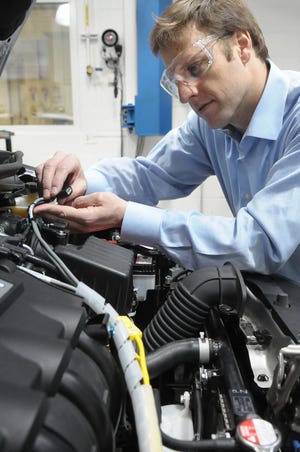A key new piece of information may soon help consumers shopping for electric vehicles, hybrids and plug-in hybrids.
The SAE engineering society is proposing a new set of rules for how to consistently evaluate those vehicles’ output, or horsepower, making it easier to compare their power and performance.
There’s no indication that any automaker intentionally inflates horsepower ratings for its electrified vehicles, but shockingly, dare I say, decades after the beginning of the hybrid revolution, well into the auto industry’s transformation to electric power, there is no standard rule for how automakers test their vehicles’ power.

Each automaker currently creates its own procedure for how it tests electrified vehicles’ power, and treats that process as proprietary — a trade secret. That means we don’t know that company A measured its EV’s power the same way company B did.
Power is one of the most important criteria consumers use when they evaluate competing models. That makes the lack of an agreed-upon standard for how to measure EVs’ power a big deal.
The proposed SME standard aims to end the uncertainty.
Called J2908, the proposed standard, which is currently being discussed and evaluated, could become an official SAE standard — the auto industry’s Seal of Approval for everything from power ratings to how much a pickup can safely tow — in a couple of years.
More:If cars could talk, they’d warn you about danger ahead, like this new system
More:GM to offer a high-end design center exclusively for Celestiq clients
“This gets everybody on the same page when we discuss power,” said Frank Markus, technical director of Motor Trend magazine. “It gets us out of the Tower of Babel and allows us all to speak the same language.”
My horsepower’s better than yours
It’s hard to believe, but for a century, every automaker had its own way to test power, test procedures that grew up over decades as engineers played it by ear. That technical Tower of Babel led to everything from meaningless chest-thumping to corporate embarrassment — and sometimes cost. During Detroit’s horsepower wars of the 1960s and ‘70s, some automakers tailored their tests to maximize claimed output — and later had to eat their words. It’s been so long, it’s hard to find records I trust 100%, and whoever’s named will say we’re singling them out, so I’d rather not. Later, differing tests in Europe, the U.S. and Japan forced some companies to lower their horsepower claims.
A new test for electrified vehicles became necessary because automakers were flying by the seat of their pants as they created new drivetrains for hybrids and electric vehicles.

“We wanted to come up with a standard to compare the amount of power at the wheels for all vehicles, regardless of whether they’re internal combustion, hybrid, electric or fuel cell,” said Michael Duoba, research engineer at the U.S. Department Energy’s Argonne National Laboratory in Illinois.
“Automakers all have their own tests. Some want to claim maximum power, others are conservative by nature.
“We need a test everybody agrees to.”
EVs, hybrids, ICE. Oh, My!
This has nothing to do with how you convert kilowatts, or kW, to horsepower, or hp. That’s a simple formula, like converting centimeters to inches: 100 kW equals 134 hp. The output of electric motors has traditionally been expressed in kilowatts, while engines’ power was measured in horsepower. Early electrical and mechanical engineers didn’t compare notes, and the two terms remained largely separate until internal combustion engines and electric motors started working together in hybrids.
The Ford Mustang Mach-E GT is an example of how a popular EV presents its power using both figures today. It’s spec sheet lists peak power at 358 kW and 480 hp. The figures mean the same thing, like “Thank you” and “Gracias.”
EVs can have one, two, three or even four electric motors, while hybrids may have a internal combustion engine (ICE) connected to a single e-motor, or an electric motor with no physical connection to the engine. The power flow — and how to measure it — is unprecedentedly complicated.
J2908 measures the maximum power available at a vehicle’s driven wheels. It includes rules for the ambient temperature when the test is conducted.
“This helps consumers compare the output of systems that are wildly different with the same yardstick,” said SAE director of publications Bill Visnic. “It reduces potential for confusion in the market.”
Volkswagen has already begun citing J2908 as the standard for testing EV power. The consumer website for its ID4 electric SUV says: “Maximum hp calculated via peak performance of the electric motor(s) at peak battery power pursuant to SAE J2908.”
J2908 can express power in either horsepower of kilowatts (kW). Comparing and converting those units, happily, is a simple equation everybody agrees to.
Contact Mark Phelan: 313-222-6731 or mmphelan@freepress.com. Follow him on Twitter @mark_phelan. Read more on autos and sign up for our autos newsletter. Become a subscriber.